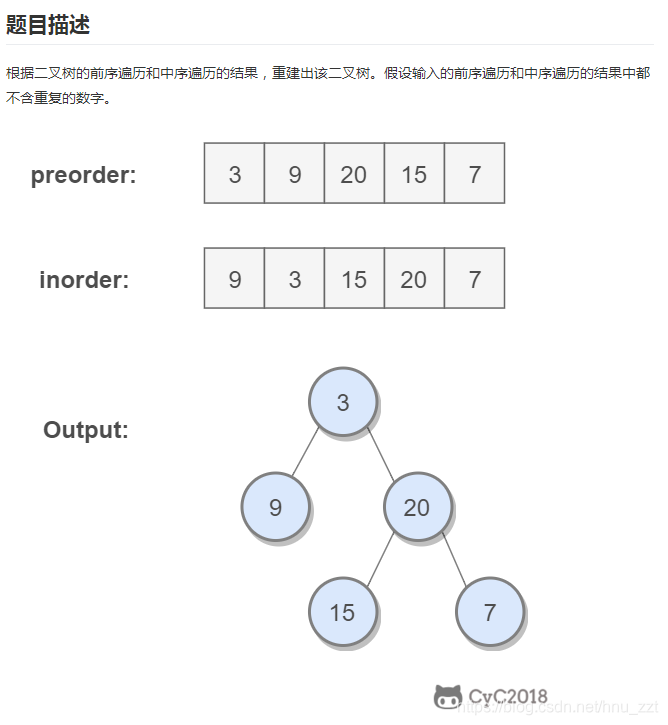版权声明:本文为博主原创文章,遵循 CC 4.0 BY-SA 版权协议,转载请附上原文出处链接和本声明。
牛客网大佬很详细的总结:https://www.nowcoder.com/discuss/198840
- 从尾到头打印链表:题目链接
题目描述: 输入一个链表,按链表值从尾到头的顺序返回一个ArrayList。
解题思路: 使用头插法可以得到一个逆序的链表。

public ArrayList<Integer> printListFromTailToHead(ListNode head) {
//头插法构建逆序链表
ListNode prev=null; //需要一个指针保存head的翻转的值
while(head!=null){
ListNode next=head.next; //需要一个指针保存next指针
head.next=prev; //翻转(头元素指向prev)
prev=head; //挪动prev指针
head=next; //挪动head指针
}
// 构建 ArrayList
ArrayList<Integer> ret = new ArrayList<>();
while (prev != null) {
ret.add(prev.val);
prev = prev.next;
}
return ret;
}
- 重建二叉树题目链接

解题思路: 利用递归思想,每次都将左右两边的子树当作一根新的二叉树处理:
1、找出二叉树的根节点
2、 构建左子树----->找出该左子树的根节点,构建该左字树的左子树,构建该左子树的右子树…直到序列中没有左子树的序列
3、构建右子树----->找出该右子树的根节点,构建该右字树的左子树,构建该右子树的右子树…直到序列中没有右子树的序列
public class Solution {
public class TreeNode {
int val;
TreeNode left;
TreeNode right;
TreeNode(int x) {
val = x;
}
}
public TreeNode reConstructBinaryTree(int [] pre,int [] in) {
TreeNode root=reConstructBinaryTree(pre,0,pre.length-1,in,0,in.length-1);
return root;
}
/**
*
* @param pre 前序遍历序列的数组
* @param startPre 前序遍历序列中 新子树开始的序号的下标
* @param endPre 前序遍历序列中 新子树结束的序号的下标
* @param in 中序遍历序列的数组
* @param startIn 中序遍历序列中 新子树开始的序号的下标
* @param endIn 中序遍历序列中 新子树结束的序号的下标
* @return
*/
private TreeNode reConstructBinaryTree(int [] pre,int startPre,int endPre,int [] in,int startIn,int endIn) {
/**
* 作为退出递归的条件
* 当该子树在序列中的开始的下标大于结束的下标时,说明已经没有子树,将该子树置为null
*/
if(startPre>endPre||startIn>endIn)
return null;
/**
* 新子树的根节点(一定是当前前序遍历序列中的pre[startPre])
*/
TreeNode root=new TreeNode(pre[startPre]);
for(int i=startIn;i<=endIn;i++)
/**
根据前序遍历的序列和中序遍历的序列,找出新子树的根节点,并递归计算新子树下的左子树和右子数
i即是中序遍历序列中本树的根节点的位置
*/
if(in[i]==pre[startPre]){
/**
*startPre = startPre + 1 :startPre是前序遍历序列中本树的根节点,所以下次递归要从本树的子树序列开始
* endPre = startPre + i -startIn :下次递归本树的子树序列结束的位置,在中序遍历序列中i的左边的所有序列都是本树的左子树,所以i也是本树的左子树的个数
*/
root.left=reConstructBinaryTree(pre,startPre+1,i-startIn+startPre,in,startIn,i-1);
/**
* 里面的加加减减好难解释啊...有种只可意会不可言传的感觉。。。
* 相信你们将程序单步调试几遍后就会明白
*/
root.right=reConstructBinaryTree(pre,i-startIn+startPre+1,endPre,in,i+1,endIn);
break;
}
return root;
}
}
整理:
用JAVA实现找出输入字符串中的出现次数最多的字符及其次数:(Map、Set的使用)
//通过Map 类实现,通过键值对的方式,可以将输入的字符串的每一个字符,作为键,每个字符出现的次数作为值:如下:
public class Find {
public static void main(String[] args){
String scan=new Scanner(System.in).nextLine();//获取键盘上输入的字符串;
Map<Character,Integer> map = new HashMap<Character,Integer>();//新建一个HashMap对象;
//通过FOR循环,把String的键值存放到map
for(int i=0;i<scan.length();i++){
char temp=scan.charAt(i);//通过循环,找到字符串的每一位字符并存入到temp中;
if(map.containsKey(temp)){//如果map里面有temp这个字符
map.put(temp, map.get(temp)+1);//把temp的值加1;
}else{//如果map里面没有temp这个字符,
map.put(temp, 1);//把temp的值设为1;
}
}
/*Collection c = map.entrySet();
Iterator it = c.iterator();
Map.Entry<Character, Integer> entry;
while(it.hasNext()){
entry = (Map.Entry<Character, Integer>) it.next();
}
*/
int maxnum = Collections.max(map.values());//调用Collections类的max方法,获取map的值的集合;并找出最大的那个值;
Set<Character> set = new HashSet<Character>();//建立一个set对象
for(Map.Entry<Character, Integer> entry1:map.entrySet()){ //通过集合的循环,把map的值放到entry1里,通过entry1找到值最大的maxnum的key;
if(entry1.getValue()==maxnum){
set.add(entry1.getKey());
}
}
System.out.println("出现次数最多的字母为:"+set+" 最多出现次数为"+maxnum);
}
}